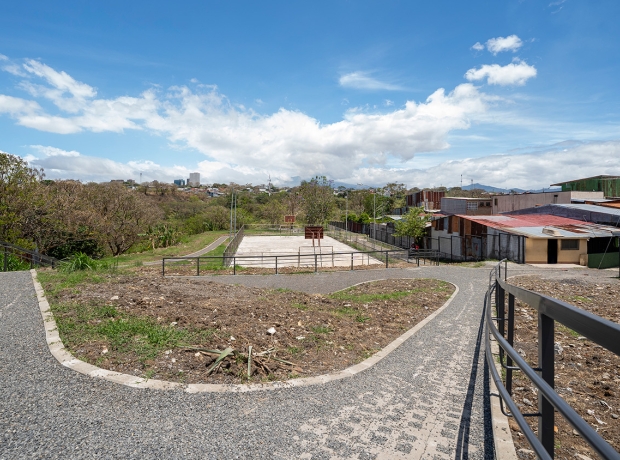Transforming a Dump Site in Costa Rica into a Community Green Space
In Costa Rica’s capital region, a locally led, GEF-funded effort to clean up trash provides a model for successful community regeneration initiatives.
Photo: Nina Cordero
The UrbanShift project will conclude in October 2025. In the program’s final year, we will be looking back to assess the impact on people, climate and nature of our support to the UrbanShift countries and cities around the world. This is the fifth piece in this series, focusing on how the UrbanShift project in Alajuelita, a city in the capitol region of Costa Rica, is driving transformative positive change for its residents. Read more from Marrakech, Teresina, Freetown and Chennai. This article originally appeared as a feature story on the GEF website.
At the heart of La Guapil, a community in Costa Rica’s capital region, is a bustling park that until recently was an open-air garbage dump.
Today, the green space larger than four soccer fields includes walking trails, gardens, and places for children to play.
Its transformation came from community organizing, local leadership, and international funding through the Global Environment Facility’s Sustainable Cities Program.
The three-hectare area in Alajuelita, bordering the Tiribí River, had long been seen as a place to leave garbage: glass bottles, diapers, plastics, cardboard, appliances like washing machines, and other waste sat out under the sun and rain, polluting the environment and causing peril for local residents.
"It was a place where people hid to commit crimes – full of mud, garbage, and dangers," said Maribel Gómez, a member of the La Guapil Community Development Association.
“For me, this project is a dream. A lot of children come here to play and now, for the first time, we have this beautiful, clean, green space where they can play safely," she said.

This initiative had its roots in work by the local community, by the Municipality of Alajuelita, and has been supported by the María Aguilar Interurban Biological Corridor (CBIMA), the European Union’s INTERLACE urban ecosystem restoration project, and the GEF-funded, UNDP-managed Transition to an Urban Green Economy (TEVU) project, a partnership with the Organization for Tropical Studies. It has also benefited from engagement by the private sector in Costa Rica, including contributions from Pedregal.
"The community of La Guapil is today full of families, children, and young people enjoying this space that previously had no value, but with vision, effort, and dedication of many people and institutions, it became a living place," said Alajuelita´s mayor Modesto Alpízar.
This change did not happen overnight. It took many hands, many hours, and enormous heart to transform a toxic site into a safe, welcoming, beautiful park.

There was wide agreement about the goal of giving new life to the troubled space. The project also benefited from existing cooperation between local, national, and international institutions through projects like Productive Landscapes, INTERLACE, and TEVU.
"It was the power of the community’s heart that wanted a dignified and safe place to connect with nature," said TEVU’s project coordinator Miriam Miranda, describing a strong push from the local government in alignment with international goals related to waste management and reforestation. "After the pandemic, green spaces and contact with nature became essential for people's health and well-being," she said.
But how exactly do you turn a “dead space” into a park?
In La Guapil, the TEVU project focused on architecture and landscaping, environmental engineering, civil engineering, and environmental education. The municipality also invested in site maintenance including pruning, lawn mowing, garbage collection, transporting soil, and debris removal.

The community was also directly involved – picking up trash, sorting waste, and planting native saplings that could help restore the ecosystem and support wildlife. They were also closely involved in efforts to create social spaces with benches and pergolas, an urban vegetable patch, and a pollinator garden. Neighbors remain closely involved through committees related to waste management, the green areas, and the urban vegetable garden.
The new space has changed life in the community, and its enduring success will require ongoing effort. Now, the challenge is the maintenance and conservation of the space, and efforts to address the quality and safety of water runoff into the Tiribí River, which borders the park and the rest of the community. This includes a proposed artificial wetland to reduce run-off through a nature-based solution.
Through its environmental education, citizen participation, and community governance, La Guapil is modeling a new approach for urban areas where environmental challenges can be compounded by poverty and inequality. Its achievements to date offer lessons to city planners, and city dwellers, around the world.
Do you have a community challenge that could follow the La Guapil model? Would you like to visit the project or volunteer with its next phase? Please contact the TEVU team at: info@tevucr.org

Transforming Pune, one neighborhood at a time
Pune's Chief Knowledge Officer talks about some of the inspiring initiatives – from electric buses to urban farms – that the Pune Smart City Corporation is implementing to make the city smarter, greener and more resilient.

Costa Rica aims to transition towards an urban green economy with GEF support
UrbanShift's local intervention in Costa Rica aims to decarbonize the San José region through sustainable integrated urban planning, supporting efforts to formulate legal reforms, promote sustainable mobility infrastructure and restore green spaces.

Building Resilience from the Community Up: Lessons from Rotterdam's People-Centered Climate Action Strategies
Over a week in Rotterdam, representatives from Latin American cities dove into the city's thoughtful approach to human-centered climate resilience in an UrbanShift-led Peer-to-Peer Exchange.

What does a green city look like?: Equitable, connected, and nature-positive
During the ClientEarth Summit, UrbanShift's John-Rob Pool joined Aditya Bahadur of the International Institute for Environment and Development and Caroline Watson of C40 Cities for a discussion on creating more sustainable, livable cities.

